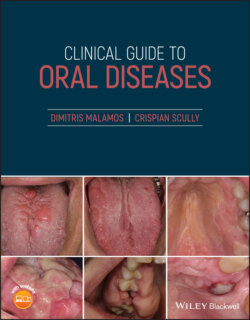Читать книгу Clinical Guide to Oral Diseases - Crispian Scully - Страница 55
Case 4.8
ОглавлениеFigure 4.8
CO: An 81‐year‐old man presented with severe pain in his mouth, and bad breath after a course of chemo‐radiotherapy for carcinoma of his palate–anterior gingivae.
HPC: The pain started after the surgical removal of a carcinoma from his palate six months ago and worsened from the end of the third week of chemo‐radiotherapy. Together with his pain, bad breath like rotten fruit was detected, remaining unchanged during the course of his treatment.
PMH: He was an old man with cachexia due to his recent treatment for an extensive oral carcinoma, while his hypertension and respiratory failure was controlled with drugs and ceasing smoking.
OE: His examination revealed a large indurate ulcer with raised margins on the skin above the right corner of his mouth (Figure 4.8). The ulcer was deep and extended to the adjacent alveolar mucosa and hard palate, and infiltrated facial skin close to his right nostril. Some superficial ulcerations covered most of his oral mucosa (mucositis grade III) together with xerostomia, halitosis, and difficulties in consuming food and drinks.
Q1 Which is/are the possible cause/s of the patient's halitosis?
1 Resistant carcinoma
2 Mucositis
3 Xerostomia
4 Malnutrition
5 Mouth breathing
Answers:
1 His extensive oral cancer and local necrosis–sepsis allow a number of anaerobic bacteria to grow and produce strong volatile gases which are easily detected by the patient and his close relatives.
2 Mucositis causes difficulties in brushing his remaining teeth, and allows the accretion of halitosis‐induced pathogenic bacteria.
3 Xerostomia occurs with halitosis in various ways. Oral dryness assists the growth of various pathogenic halitosis bacteria, by reducing the mechanical washing–cleaning action of saliva or eliminating various antimicrobial components (enzymes, immunoglobulins). Xerostomia was seen and induced by the damage of the salivary glands (minor and major) with radiotherapy and boosted with the reduced fluid consumption due to patient's mucositis‐induced dysphagia.
4 The malnutrition of this patient, due to his eating and swallowing problems from mucositis, causes his liver to break down the lipids and proteins for energy and release of ketones into the blood. When these substances reach the lungs, they are exhaled into the air, producing breath smelling of rotten fruit.
5 No
Comments: Mouth breathing causes a temporary oral dryness and halitosis that easily go with fluid and food consumption and teeth brushing.
Q2 What are the other causes of cachexia apart from oral cancer?
1 Acquired immunodeficiency syndrome
2 Diabetes mellitus
3 Anorexia nervosa
4 Kwashiorkor
5 Hyperthyroidism
Answers:
1 Patients with full‐blown AIDS are often characterized by loss of weight, muscle atrophy, fatigue, weakness, and loss of appetite (typical characteristics of cachexia).
2 No
3 No
4 No
5 No
Comments: Diseases such as uncontrolled diabetes mellitus and hyperthyroidism are characterized by weight loss due to increased metabolism of fat and muscles. Anorexia nervosa is a typical example of marasmus; a condition characterized by energy deficiency due to severe malnutrition, while in Kwashiorkor, the malnutrition involves only protein intake.
Q3 Which pathogens are isolated in oral mucositis lesions?
1 Candida spp.
2 Pseudomonas aeruginosa
3 Herpes simplex
4 Mycobacterium ulcerans
5 Treponema pallidum
Answers:
1 Radio‐chemotherapy disrupts the epithelial barrier and alters the host immunity allowing the entrance and growth of Candida species such as albicans, glabrata, krusei, and tropicalis in mucositis lesions.
2 Pseudomonas aeruginosa and Escherichia coli are among the Gram‐negative bacteria which grow in increased numbers in oral mucositis lesions.
3 Alterations in a patient's immunity allow the growth of fungi and viruses like Candida and Herpes species in oral mucositis.
4 No
5 No
Comments: Mycobacterium ulcerans is a slowly growing mycobacterium infecting the skin and subcutaneous tissues but not oral mucosa causing non‐ulcerated nodules/plaques and ulcerated lesions. Treponema pallidum is responsible for ulcerations in syphilis and not in mucositis.
